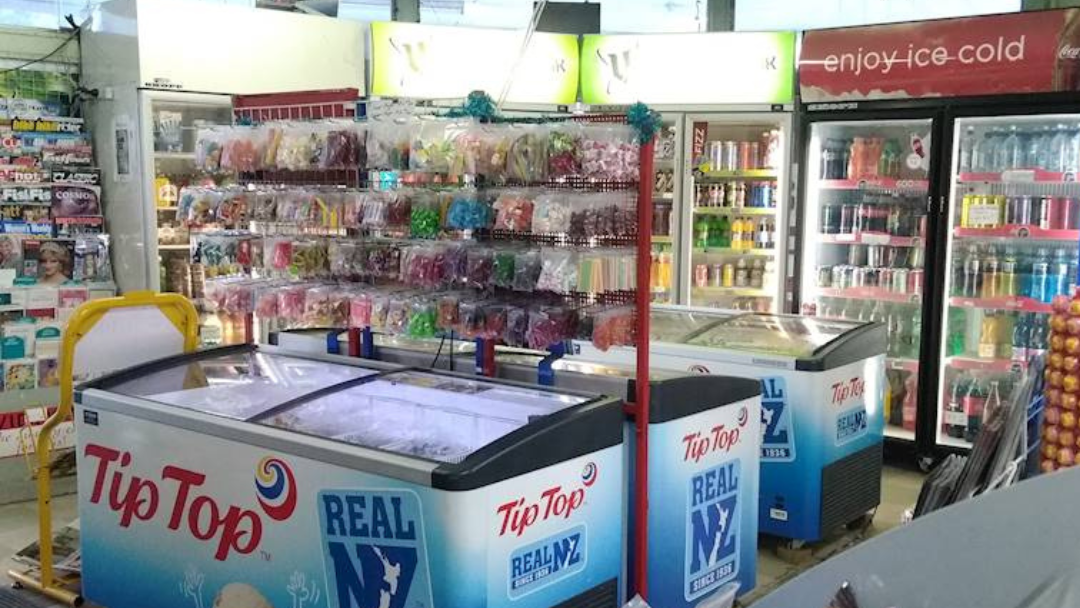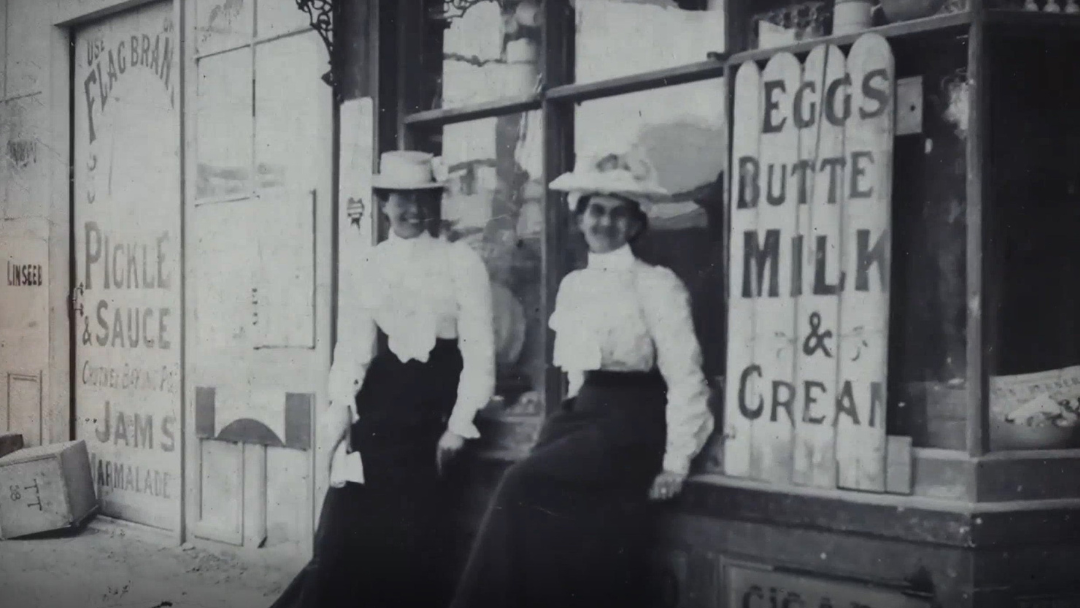In a recent video, I talked about the word “dairy”. We learned that here in New Zealand, “dairy” can mean one of two things: a) products made from cow’s milk – like in “dairy cow” or “dairy farm” or b) a convenience store – as in “I got some snacks from the dairy.”
The use of the word “dairy” when talking about a convenience store often puzzles visitors and causes them to wonder…”Why on earth is it called a dairy?” It’s a good question. A question I didn’t know the answer to, so I found out.
Here’s what I found…
Introduction
Dairies have been around for as long as I can remember… In fact, they’ve been around since before I was even born. And despite their humble size and modest nature, dairies have played a huge role in the lives of New Zealanders all over the country. And surprisingly, they’ve got a pretty interesting history to tell, too.
Dairies as we know them today are the ultimate one-stop-shop, right? Groceries, lollies, an ice-cream, a pie, batteries, lip balm…whatever you need, they’ve got it. They’re convenient, and they’re everywhere. I’d take a guess that I stop by my local dairy at least once a week.
But dairies haven’t always been this way. Things used to be different…
Dairies are well-stocked with a variety of food and drink. While some offer plenty of grocery ingredients including canner goods, fruit and vegetables, others focus more on junk food and snacks. Many offer both.

A typical Kiwi dairy
Evolution of the Dairy
WHERE IT ALL BEGAN
To understand the birth of the quintessential Kiwi dairy, we have to go back in time. I mean, waaaaay back in time… back to the early 19th century. Not sure what life was like then? Let me paint you a picture.
Imagine a time before supermarkets, before cars, before refrigerators. This is how life was in the early 1900s. Back then, ‘town’ was a cluster of small shops on the main street.
What kind of shops were there? Well, there was the butcher who sold meat. The baker, who baked fresh bread every day. Fruit and vegetables were sold at the green grocer or fruiterier. Fishermen sold fish directly to customers, sometimes straight off of the wharf. In fact, it wasn’t unusual for people to sell fruit and vegetables from baskets on street corners or to go hawking. And there was also the grocer, who sold baking staples such as flour, sugar, spices and other dried goods. Each business had their speciality, and customers would go from shop to shop collecting goods.
And as for milk products? Well, they were sold in little stores called “dairy produce sellers.” And this is where the story of the dairy begins. Dairy produce sellers, as I write about in detail below, were small shops that sold – as the name suggests – dairy products.
Here we see women in front of a dairy produce seller. Notice the sign advertising the few products available to buy – eggs, butter, milk & cream.

Shoppers pose outside a dairy produce seller. Image from The Changing Face of the New Zealand Dairy
Early 1900s
SHOPPING & RETAIL
So what was life like in the good ‘ol days then? Well, to be honest, it sounds kind of tough… Because there was no refrigeration or cars, the shopping had to be done regularly – every two or three days. Women walked to town on foot and carried their shopping home in a basket. For heavier items, most stores offered a delivery service (and by ‘delivery service’ I mean that they had their goods dropped off by horse and cart, or sometimes a rickshaw…there were no cars, remember!)
There were a lot of strict laws back then, too. Laws about what hours a shop could be open for and what products they could sell. Dairy produce sellers, for example, were the only shops allowed to sell dairy products by law. And what’s more, they only sold a total of five goods – milk, cream, cheese, butter and eggs. They were also the only shop allowed to open on a Sunday, while all other shops were restricted to opening Monday to Friday.
Before supermarkets there were lots of small shops who each had a specialty. For example, the grocer, the butcher, the fruiterier, the dairy produce seller, among others. Many shops offered delivery services by horse and cart.

An old New Zealand town. Image from The Changing Face of the New Zealand Dairy
1930s
THE DEPRESSION
Jump forward to the 1930s, and New Zealand is facing hard times. It’s the depression. While many families receieved an allowance from the government for groceries, money was tight. So, in an effort to make some extra cash, people started selling things from home. Some people set up a small shop at their house by either building a room on the front of their house or converting an existing room. They sold a mix of grocery items, lollies and other small goods. At the same time, many shop owners were converting their fruit and vegetable shops to sell other groceries.
It’s likely many of these sales were illegal. Strict laws were still in place around what shops could and couldn’t sell, but people were desperate. So, despite restrictions, little shops popped up around town and became a part of everyday life.
As these shops emerged, so, too, did a new word: “dairy”. An abbreviation from the earlier term, “dairy produce sellers”, “dairy” came to be used as a catch-all term for small mixed grocery stores. And it’s been that way ever since.
Have you ever noticed how many dairies appear to have been built onto the front of houses? It’s because they were. During the depression some families started selling goods from a small room in their house, which they either built or converted into a small shop. Plenty of these dairies are still around today.

An makeshift dairy during the depression. Image from The Changing Face of the New Zealand Dairy

Daniell Street Dairy, Newtown, Wellington (2006). Photo by Phillip Capper on Flicker
1940s
INCREASED TRADING HOURS
The 40s were a time of change, especially when it came to laws. As a result of the tough restrictions on opening hours and approved goods, there was a lot of illegal trading. In response, the government relaxed the laws, allowing some stores to have longer opening hours and increasing the number of approved goods.
This was great for dairies. They were one of the few stores that were allowed to open on Saturdays, and they could now sell more goods than ever. Business was going well.
Corner dairies were thriving in the weekends from the 1940s to the 1980s when most other stores were closed. They often had bold advertising on their walls for products they sold, like in this picture where they sold Bushells tea. Nowdays of course you’ll see big brand such as Coca cola, Tip Top and Streets.

A dairy in Freeman’s Bay, Auckland (1980). Image from Te Ara – The Encyclopoedia of New Zealand
1950s
NEW TECHNOLOGY
With the increased trading hours and the freedom to sell a variety of products, the 50s got off to a great start for dairies. Business was booming. Until…
…the advance of technology. The 50s brought with them the development of cars, refridgeratiors, and other cutting edge tech. Initially, few New Zealanders could afford to buy cars or fridges and not much changed. But, as the years passed, more and more Kiwis were able to make these big puchases. And as they did so, life for dairy owners changed dramatically.
By the 1960s cars had become the norm and people swapped their old habit of shopping on foot to going by car. And where did they go? Well, the shiny new supermarkets of course! Boasting big car parks and a huge store where you could get all your items in one place, supermarkets were tough competition for the grocers, dairies, fruiteriers and other small stores.
Not only that, but people now had refrigerators at home, which meant that they no longer needed to shop several times a week. Shopping had changed for good.
Supermarkets came to New Zealand in the 60s and made a huge impact on Kiwis’ shopping habits. As more and more families bought cars, refridgerators, and other appliances, they spent less and less time and money at dairies and other small stores, opting instead for the convenience and affordability that supermarkets offered.

The second supermarket that opened in New Zealand (1961). Image from Te Ara – The Encyclopoedia of New Zealand
1970s
ARCADES, MILKSHAKES & MORE
By the 70s the impact of these developments were clear. Smaller shops were less and less common, driven out of business by the supermarkets. Dairies did their best to stay afloat, expanding their product range even more and introducing novel services to bring customers in. For example, some dairies had arcade machines on-site, while others started selling milkshakes and hand-rolled icecream in a cone.
Kids and teens flocked to dairies for something to do – it was a place to hang out and pass the time. Meanwhile, supermarkets were closed weekends while dairies were open seven days a week, giving them a small advantage to drive sales.
Milkshakes and icecreams were all the rage in the 70s.

A dairy advertises milkshakes on shop sign. Image from The Changing Face of the New Zealand Dairy

A group poses with handrolled icecreams. Image from The Changing Face of the New Zealand Dairy
1980s and beyond
SUPERMARKET TAKEOVER
As time went on, the battle between dairies and supermarkets continued. Once again, the government relaxed laws and supermarkets were able to increase their opening hours to include weekends and evenings. They continued to expand their range, and by the 2000s supermarkets had everything a small village used to; a fishmonger, a butcher, a confectioner, a delicatessen, a bakery, a greengrocer, a fruiterier, a grocer, a liquor store – all rolled into one. Moreover, they had the advantage of buying in bulk, which meant they could buy and sell for a much cheaper price.
As you can imagine, this won a lot of customers. The convenience and affordability offered by supermarkets was hard to beat, and unfortunately many dairies went out of business.
Dairies struggle to compete with the convenience and affordability of big supermarkets…In the pooter below they try to win back customers with promises of excellent customer service and “supermarket features”.

A dairy advertisement. Image from The Changing Face of the New Zealand Dairy
Today
CONVENIENCE STORE & TAKEAWAYS
Fast forward to today, and dairies have evolved to become something between a convenience store and a superette. While much has changed over the years, plenty of the original products and services remain. Mixed grocery goods are available, of course, as well as lollies, icecream, and more. Depending on where you go, you can even find some dairies that still sell hand-rolled icecreams and milkshakes – a service that was all the rage in the 70s. I haven’t seen an arcade machine yet, though!
As the world changes and customer demands grow, dairies are growing and changing, too. Nowadays, many dairies offer takeaway foods, for example. Chicken and chips, freshly baked croissants, seasonal fruit & veg… and customers love it! In fact, I recently came across a dairy selling a vegan pie…something that was unheard-of only ten years ago.
Like the 50s, the threat of big corporations still looms over dairies and they have even more competition than ever – 24 hour gas station stores and online shopping, to name a few – but so far they are proving to be as resilient as ever, adapting and responding to customer needs and continuing to serve Kiwis all over the country.
While it’s common for supermarkets, gas stations, and dairies to be open seven days a week and to stay open until late, this is a relatively recent change. For a while, dairies were allowed to have much longer trading hours than other stores, but things have more or less evened out now.

A dairy in Freeman’s Bay, Auckland (1980). Image from Te Ara – The Encyclopoedia of New Zealand
Conclusion
DAIRIES AND NZ
So there you have it… a brief history of the evolution of dairies in New Zealand over the past 100 years. I started this post with a simple question, ‘why are convenience stores called ‘dairy’ in New Zealand?’ but the answer, I discovered, revealed so much more about New Zealand life and history than I expected. I really enjoyed tracing the history of dairies in New Zealand and I hope in writing this I could paint a clear picture for you to learn from, too.
I, for one, have a fondness for dairies (perhaps it’s all the memories of buying lollies at the local dairy when I was a kid…) and hope they stay with us for years to come.
Dairies then and now. Same… but different, eh?

Onehunga Dairy. Image from The Changing Face of the New Zealand Dairy

A typical Kiwi dairy.
Further learning
RECOMMENDED RESOURCES
Another resource I found particularly helpful was Te Ara Encyclopoedia of New Zealand. A complete guide to New Zealand peoples, environment, history, culture, and society, Te Ara is a fantastic resource that I highly recommend.
Tip! If you’re not interested in reading, check out this photo album instead!
Sources
Rakena, M (Director & Producer). (2020). The Changing Face of the New Zealand Dairy [Video File]. Retrieved from https://www.nzonscreen.com/title/changing-face-of-the-nz-dairy-2020/overview
Carl Walrond (2010, 11 Mar), Food shops – Dairies, Te Ara – the Encyclopedia of New Zealand. http://www.TeAra.govt.nz/en/food-shops/page-5 (accessed 12 February 2023)







0 Comments